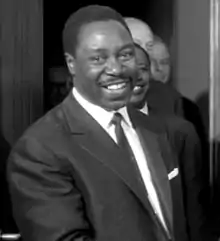Louis Lansana Beavogui
Louis Lansana Beavogui (28 December 1923 – 19 August 1984) was a Guinean politician. He was Prime Minister from 1972 to 1984 and was briefly interim President in 1984.
Louis Lansana Beavogui | |
|---|---|
 | |
| President of Guinea Interim | |
| In office 26 March 1984 – 3 April 1984 | |
| Prime Minister | Himself |
| Preceded by | Ahmed Sékou Touré |
| Succeeded by | Lansana Conté |
| 1st Prime Minister of Guinea | |
| In office 26 April 1972 – 3 April 1984 | |
| President | Ahmed Sékou Touré Himself (Acting) |
| Preceded by | Post established |
| Succeeded by | Diarra Traoré |
| Personal details | |
| Born | 28 December 1923 Macenta, French Guinea (now Guinea) |
| Died | 19 August 1984 (aged 60) Conakry, Guinea |
| Spouse(s) | Delphine Béavogui (?–1984; his death) |
Background and political career
Beavogui, a member of the Toma ethnic group,[1] was born in Macenta, located in southern Guinea. He was trained as a doctor at the School of Medicine and Pharmacy in the Senegalese city of Dakar to become a medic.[2] He first worked as an assistant medical officer in Guéckédou and then as a medical officer in Kissidougou. His political career began in 1953 as a town councillor. He was elected as Mayor of Kissidougou when he was 31 years old in 1954, and elected to the National Assembly of France in January 1956 as one of three deputies representing French Guinea. Under President Ahmed Sékou Touré, Beavogui was appointed to the government as Minister of Economic Affairs and Planning when Guinea gained its independence in 1958, and he was appointed as Minister of Foreign Affairs in 1961. After the Guinean government allowed Kwame Nkrumah, the ousted President of Ghana, to live in exile in Guinea, the authorities in Ghana detained Beavogui at the airport in Accra while he was on his way to Ethiopia for a conference of the Organization of African Unity in October 1966. He remained Foreign Minister until May 1969, when he was moved back to his position as Minister of Economic Affairs.[3]
At the end of the Ninth Congress of the ruling Democratic Party of Guinea (PDG) on 25 April 1972, President Touré said that Beavogui would become Prime Minister; that position had not previously existed.[3] Beavogui served as Prime Minister from 26 April 1972 to 3 April 1984.
Interim Presidency and military coup
Touré died on 26 March 1984. Per the Constitution, Beavogui succeeded Touré and acted as interim President until 3 April, when he was deposed in a military coup led by Lansana Conté and Diarra Traoré.[1] The coup took place just hours before the PDG's political bureau was to select a new leader. Beavogui, a close friend of Touré, was widely expected to succeed him.[4] The newly-minded PDG leader would have automatically elected to a seven-year term as president and confirmed in office in a referendum that spring.
Following the coup, Beavogui was imprisoned in Kindia until being taken to Conakry for medical treatment.[5] He died of diabetes[6] while hospitalized in Conakry in August 1984.[5]
See also
References
- Thomas O'Toole and Janice E. Baker, Historical Dictionary of Guinea (4th edition, 2005), Scarecrow Press, page lxiv.
- "Louis Lansana Béavogui 1923–1984". webGuinée. Archived from the original on 2012-03-22.
- Historical Dictionary of Guinea, page 28.
- "GUINEA'S MILITARY ASSUMES CONTROL; SEALS OFF NATION". The New York Times. 4 April 1984. Retrieved 26 October 2018.
- "Jul 1985 - Government changes - Foreign and economic policy of military government - Release of detained members of former regime - Attempted coup", Keesing's Record of World Events, Volume 31, July, 1985 Guinea, Page 33709.
- West Africa Annual (13th edition, 1996), page 188.
| Political offices | ||
|---|---|---|
| Preceded by Ahmed Sékou Touré |
Foreign Minister of Guinea 1961–1969 |
Succeeded by Saifoulaye Diallo |
| Preceded by Post Abolished |
Prime Minister of Guinea 1972–1984 |
Succeeded by Diarra Traoré |
| Preceded by Ahmed Sékou Touré |
President of Guinea (interim) 1984 |
Succeeded by Lansana Conté |